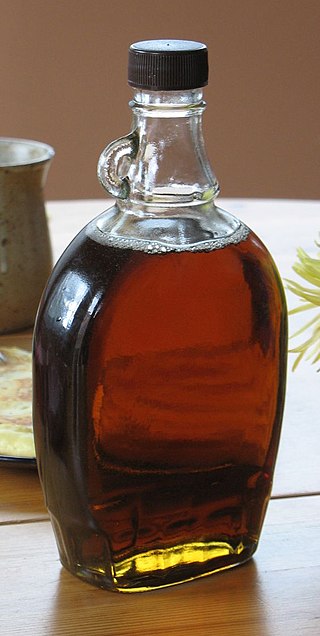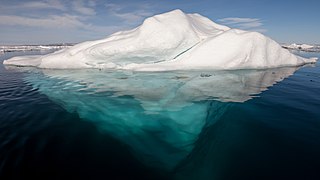Related Research Articles

Maple syrup is a syrup made from the sap of maple trees. In cold climates, these trees store starch in their trunks and roots before winter; the starch is then converted to sugar that rises in the sap in late winter and early spring. Maple trees are tapped by drilling holes into their trunks and collecting the sap, which is processed by heating to evaporate much of the water, leaving the concentrated syrup.

Vodka is a clear distilled alcoholic beverage. Different varieties originated in Poland, Russia, and Sweden. Vodka is composed mainly of water and ethanol but sometimes with traces of impurities and flavourings. Traditionally, it is made by distilling liquid from fermented cereal grains and potatoes since the latter was introduced in Europe in the 18th century. Some modern brands use corn, sugar cane, fruits, honey, and maple sap as the base.

Whisky or whiskey is a type of liquor made from fermented grain mash. Various grains are used for different varieties, including barley, corn, rye, and wheat. Whisky is typically aged in wooden casks, which are typically made of charred white oak. Uncharred white oak casks previously used for the aging of port, rum or sherry are also sometimes used.

An iceberg is a piece of freshwater ice more than 15 meters long that has broken off a glacier or an ice shelf and is floating freely in open water. Smaller chunks of floating glacially derived ice are called "growlers" or "bergy bits". Much of an iceberg is below the water's surface, which led to the expression "tip of the iceberg" to illustrate a small part of a larger unseen issue. Icebergs are considered a serious maritime hazard.

Ginger ale is a carbonated soft drink flavoured with ginger. It is consumed on its own or used as a mixer, often with spirit-based drinks. There are two main types of ginger ale. The golden style is credited to the Irish doctor Thomas Joseph Cantrell. The dry style, a paler drink with a much milder ginger flavour, was created by Canadian John McLaughlin.

Smirnoff is a brand of vodka owned and produced by the British company Diageo. The Smirnoff brand began with a vodka distillery founded in Moscow by Pyotr Arsenievich Smirnov (1831–1898). It is distributed in 130 countries, and manufactured locally in some, as in Illinois in the United States.

Sloe gin is a British red liqueur made with gin and blackthorn fruits (sloes), which are the drupe fruit of the Prunus spinosa tree, which is a relative of the plum. As an alcoholic drink, sloe gin contains between 15 per cent and 30 per cent alcohol by volume (ABV); however, European Union regulations established 25 per cent ABV as the minimal alcoholic content for the blackthorn beverage to be a sloe gin. Historically, despite being a liqueur based upon gin, the EU included the colloquial name sloe gin to the legal definitions; thus, sloe gin is the only alcoholic beverage that legally uses the term gin without appending the liqueur suffix.

Canadian cuisine consists of the cooking traditions and practices of Canada, with regional variances around the country. First Nations and Inuit have practiced their culinary traditions in what is now Canada for at least 15,000 years. The advent of European explorers and settlers, first on the east coast and then throughout the wider territories of New France, British North America and Canada, saw the melding of foreign recipes, cooking techniques, and ingredients with indigenous flora and fauna. Modern Canadian cuisine has maintained this dedication to local ingredients and terroir, as exemplified in the naming of specific ingredients based on their locale, such as Malpeque oysters or Alberta beef. Accordingly, Canadian cuisine privileges the quality of ingredients and regionality, and may be broadly defined as a national tradition of "creole" culinary practices, based on the complex multicultural and geographically diverse nature of both historical and contemporary Canadian society.

Aero is an aerated chocolate bar manufactured by the Vevey-based company Nestlé. Originally produced by Rowntree's, Aero bars were introduced in 1935 to the North of England as the "new chocolate". By the end of that year, it had proved sufficiently popular with consumers that sales were extended throughout the United Kingdom.

Gordon's is a brand of London dry gin first produced in 1769. The top markets for Gordon's are the United Kingdom, the United States and Greece. It is owned by the British spirits company Diageo. It is the world's best-selling London dry gin. Gordon's has been the UK's number one gin since the late 19th century. A 40% ABV version for the North American market is distilled in Canada.

The International Ice Patrol is an organization with the purpose of monitoring the presence of icebergs in the Atlantic and Arctic oceans and reporting their movements for safety purposes. It is operated by United States Coast Guard but is funded by the 13 nations interested in trans-Atlantic navigation. As of 2011 the governments contributing to the International Ice Patrol include Belgium, Canada, Denmark, Finland, France, Germany, Greece, Italy, Japan, the Netherlands, Norway, Panama, Poland, Spain, Sweden, the United Kingdom, and the United States.
The Polmos Łańcut distillery is one of the oldest producers of liquors and liqueurs in Poland. A small amount of the distillery's output is exported to Belgium, the Netherlands, France, Great Britain, Germany, Italy, and the United States.

Newfoundland and Labrador is the easternmost province in Canada. The Strait of Belle Isle separates the province into two geographical regions, Labrador and the island of Newfoundland. The province also includes over seven thousand small islands.

Wódka Żołądkowa Gorzka − colloquially shortened to Żołądkowa Gorzka or Żołądkowa − is a herbal vodka from Poland, and the leading brand of Polmos-Lublin/Stock Polska since 1950.

Crystal Head Vodka is a brand of vodkas manufactured by Globefill Inc. in Newfoundland and Labrador, Canada. It was conceived and founded by actor Dan Aykroyd and artist John Alexander in September 2008. The vodkas are quadruple-distilled, filtered seven times and packaged in a glass bottle modeled after a crystal skull.
Chase Vodka is a single estate potato vodka made in Herefordshire, England, UK by William Chase, who is also known for founding Tyrrells crisps.
Belvedere Vodka is a brand of Polish rye vodka produced and distributed by LVMH. It is named after Belweder, the Polish presidential palace in Warsaw, whose illustration appears on its bottles. It is produced in the town of Żyrardów in Poland.

William Chase is a British entrepreneur. He is the founder of the Tyrrells Potato Chips brand and Chase Distillery, Ltd. that produces Chase Vodka and Williams Gin and more recently Willy's Probiotic Live Foods that produces fermented foods and drinks.
Rock Spirits is the manufacturing division of the Newfoundland and Labrador Liquor Corporation, a provincial crown corporation of the Canadian province of Newfoundland and Labrador. It is the only remaining Canadian Liquor Board to have a manufacturing division. It has been in operation in St. John's for over 65 years.
References
- ↑ Joseph, Andrew (21 December 2010), Breaking the ice, Canadian Packaging, archived from the original on 1 January 2011, retrieved 11 April 2013
- 1 2 Immen, Wallace (13 June 2013), Iceberg Vodka floats new flavours in crowded spirits market, The Globe and Mail, retrieved 2 February 2014
- ↑ Powell, Chris, Iceberg Vodka shakes up a new look and marketing platform, Marketing Magazine, retrieved 2 February 2014
- 1 2 Iceberg Vodka, The Canadian Business Journal, archived from the original on 20 February 2014, retrieved 2 February 2014